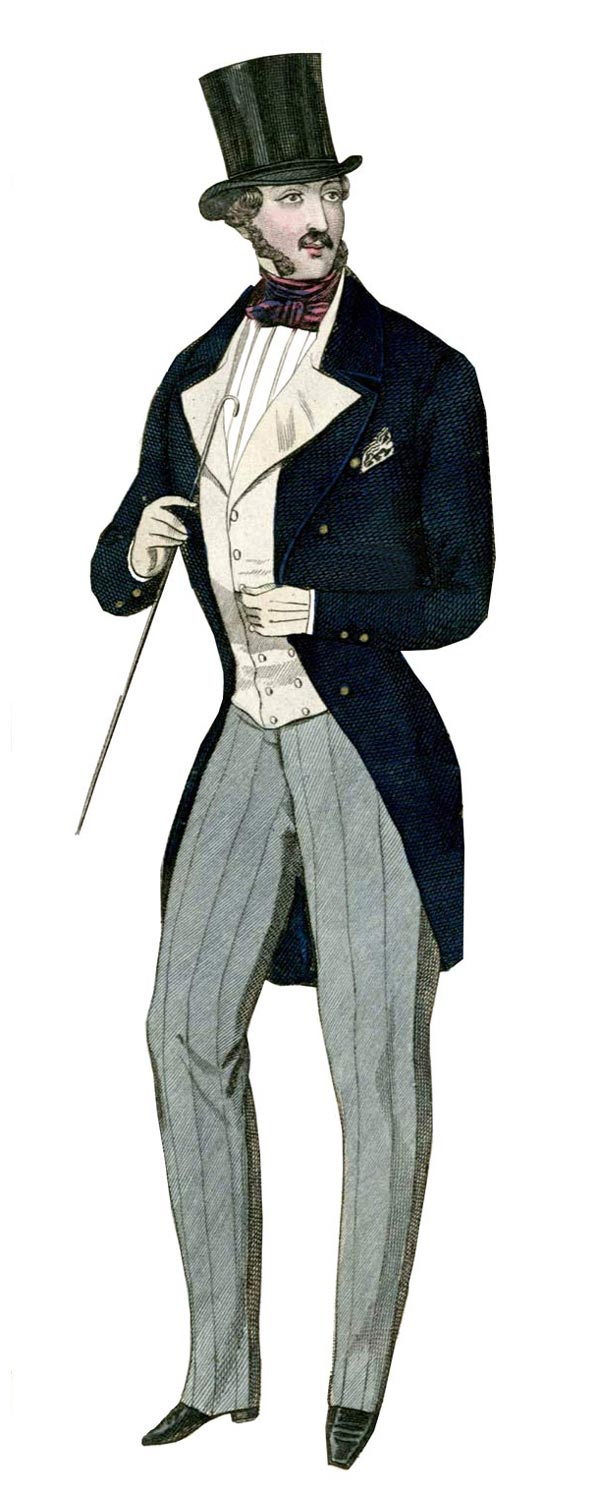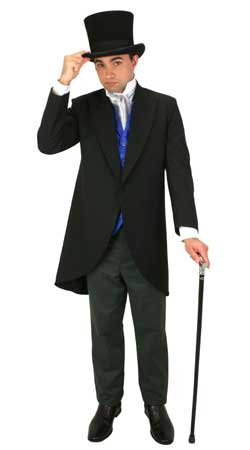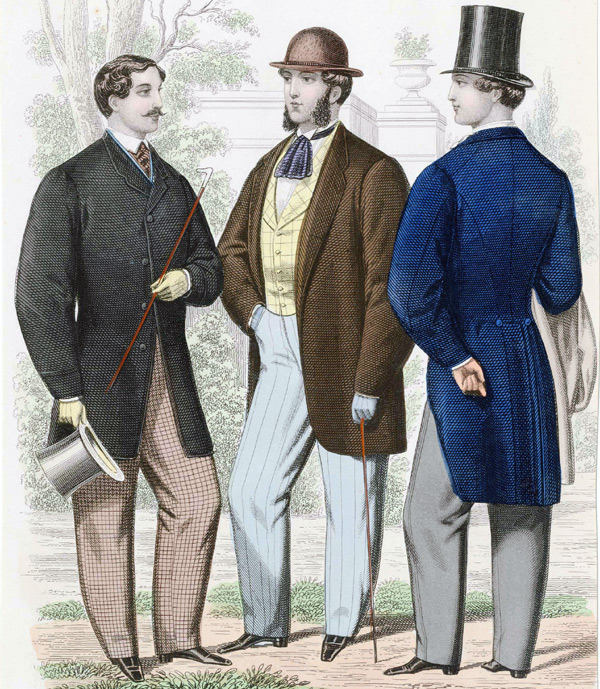Prices and Availability Subject to Change. Please call 800-997-4311 for more Information.

Mens Early Victorian Clothing (1830's - 1870's)
The lengthy Victorian Era brought about many changes in men's fashion, whether prince or pauper. Beginning with the reign of Queen Victoria in 1837 and lasting until the turn of the 20th century, the early decades of this period ushered in cultural and industrial changes impacting what men wore at home, work and social situations.
This period sees a major evolution in Western menswear from the peacocking dandies of Regency and Romantic eras to the more serious, understated style of the late Victorian gentleman, and the emergence of the menswear staples as we know them today. . But, unlike the expensive, custom-made fashions reserved for the wealthy, clothing became increasingly accessible to the everyman as the Industrial Revolution took off and newly-invented sewing machines hummed in high gear to keep up with demand.
Ready-to-wear suits, dress and work shirts, and other garments were increasingly accessible in the bustling department stores of larger cities as well as through catalog companies - it was the beginning of the end for homemade clothes. These efficiencies in manufacturing and distribution drove prices down, providing nearly every man the opportunity to dress a little better whether for farm or fete!
Learn MoreComplete Early Victorian Outfits
We offer a full line of men's period clothing which are suitable for movie and TV production, theatrical, living history and performing arts requirements, and are also perfect for vintage weddings!
All of the products we sell are sold individually, but we have put together these full outfits to showcase the elements of Regency style for your consideration and inspiration.
Click any image for a close-up and a list of the products shown.

Elements of Early Victorian Style


Even with increased availability to the masses, gentlemen's fashion was still heavily influenced by the upper echelons of society, especially the whims of royalty. HRH Prince Albert, the Queen's husband and royal consort, was youthful at the time of his wife's coronation and was fastidious in his appearance, immortalizing him as the poster-boy for this early era's elegance -- what he wore in public most often became the latest fashion rage.
Early Victorian Coats - At the beginning of this early Victorian period two types of coats were commonly worn: the tailcoat and the frock coat. The tailcoat of the Regency era was still very much in style for formal day and evening wear, while frock coats were established in the 1830s as fashionable, albeit informal, daywear. However, by the middle of the century the Frock Coat would and would go on to fully displace the tailcoat as daywear by the middle of the century evolving from the English riding coat, seamed at the waist and skirted to mid-thigh.
With tailored waists, full skirts, puffed sleeveheads and rounded puffed out chests, these early frock coats were the fullest expression of the Romantic aesthetic, especially paired with layers of colorful waistcoats and billowing silk neckwear for the most extravagant dandies of the time. Through the 1840s the general silhouette lengthened, and, although jackets were still narrow and the skirts were still full, sleeves were no longer puffed at the shoulder and waist seams were dropping. The next big evolution came in the mid-1850s, when styles relaxed into a much more generous cut and the tailored waistline was replaced by a longer, straighter silhouette, dropped shoulders and wide lapels, a look which defined much of the 1860s.
Early in the royal marriage, the Queen's consort popularized the double-breasted frock coat (originally a "top-frock" overcoat), and the regal, refined shape was mimicked by the masses and eponymously dubbed the "Prince Albert", remaining in fashion for decades after his untimely passing.
The mid-Victorian period saw the rise in popularity of two newer styles of coat: The cutaway or "morning coat" with its waist seam and sloping, cutaway hem, retaining its sporty feel from the English riding coat or "Newmarket" it evolved from, was an alternative to the frock coat from the 1850s, and standard formal business attire by the 1860s, as the frock became increasingly relegated to the most formal occasions.
The mid-1850s also saw the introduction of a new choice for casual or sporting events: the sack jacket. Cut shorter, and without a waist seam, the sack jacket was a practical, comfortable and fashionable choice which by the end of the century would become the central piece of a man's wardrobe.
Whichever style one chose, colors grew darker for coats and jackets throughout this entire period with black being the benchmark, but also deep browns, blues, charcoals and olive drabs were on the scene, although lighter linens could be worn in summer.
Vests / Waist Coats - Not all early Victorian fashion was somber-toned; wearing a brightly-hued waistcoat (and/or tie) was the manner in which a gentleman added a pop of color and personality to his ensemble. Open trade routes to Asia drove down the import cost of these desirable fabrics -- no white shirtsleeves were complete without a dashing waistcoat - and often more than one for the true Romantic dandy!
Gone were the tall collars of the regency period - rolled shawl collars with a deep V were the fashion in vests through the 1830s and 1840s, and could be padded and shaped with darts for the fashionable silhouette of the time. Conservative dark vests in wool or cotton became the norm for daywear in the 1850s and 1860s, appointing gentlemen, bankers, bean counters and merchants alike, although one could still let loose with bright, patterned silks for dress occasions. As it was considered impolite, if not plain uncouth, for a man to be seen in bare shirtsleeves by anyone other than his wife, even laborers donned utilitarian vests of denim, dock canvas and heavier cotton.
Victorian Trousers - Pants and trousers evolved during this period to become the men's pants we know today. Trousers of the 1830s and 1840s were still slim cut. Tight fitting ankle length pantaloons, a holdover from the Regency era, were still de rigeur for evenings. For daywear, trousers became more loose fitting as the decades wore on, albeit with instep straps to maintain a smooth line. Trousers were generally made in lighter colors than the coat, and could even be seen in checks and tweeds.
By the mid-century trousers were evolving to become the men's pants we know today - pantaloons were relegated to riding gear, and as of the early 1840s, the fall-front opening had been replaced by a center button fly front. The instep strap had also disappeared, and the general relaxing of the whole men's silhouette in the mid-1850s produced wide billowing pant legs, almost always held up by a pair of suspenders, a style which would remain in fashion for the next decade or so. Pants could be light or dark, and were still seen in stripes and checks. However, patterned pants became less common towards the end of the 1860s, as menswear became ever more serious and understated.
Victorian Shirts - A white starched shirt was still the staple in dress shirts, but underwent several changes as fashions in neckwear evolved. The elaborate cravat styles of the preceding Regency era persisted through the Romantic 1830s, and were accompanied by decorative shirt fronts - pleats for the day, frills for the evening, atop deep cut, highly decorative waistcoats.
As these fell out of favor however, shirt collars began to change. Shorter collars became common as the decades progressed. The collars could be separate or attached to the shirt, and, in the 1860s, were increasingly worn folded down like men's shirts of today. Detachable collars and cuffs were expected for dressier or formal occasions. Work shirt styles were less rigid and included full-placket and pull-over styles, bib fronts and a wide selection of colors, stripes and patterns.
Victorian Hats - Top hats remained firmly in fashion throughout this period for both day and evening wear, worn with tailcoats, frock coats, and the newer cutaways and sack jackets, right up until the end of the 1860s, when it was the Derby (or "bowler") hat that became standard daywear.
Hats reached dizzying heights in the early 1860s with a fashion for the stovepipe top hat, seven or eight inches high, and comically tall derbies, but shrunk down again by the 1870s. Newsboy and Applejack style caps with eight panels were prolific as both a working class hat and as gear for golf, croquet and other higher-society sporting activities. As the 1860s progressed, derbies became more common along with billed caps such as the kepis worn by soldiers during the war.
Victorian Cravats and Ties - Tall and elaborately tied cravats and stocks (a stiff band, fastened at the back, covered with an arrangement of silk or muslin) were still the fashion as Queen Victoria ascended the throne in 1837, thanks to Romantic era dandies like D'Orsay and Disraeli, whose waterfall cravats, held in place with a decorative pin, made quite the splash in high society.
After 1840 neckwear became less flamboyant, stocks and cravats still tall but tied in a flat bow which would become the fashion for the coming decades; dark slim silk ties in large flat bows in the 1850s (tied at a jaunty angle if you so desired), slender bow ties in vogue in the 1860s, before the 1870s saw the origin of the four-in-hand knotted tie as we know it today. True dandies wore large and brightly colored bow ties, but sedate bow ties and puff ties were more commonplace.
Victorian Footwear - Boots remained the most common style of footwear but were often shorter in length, and worn under the trousers, rather than on top as was the Regency fashion. Laced shoes, popularized by Thomas Jefferson, and Congress Gaiters were also in step for the time. Spatterdashes (Spats) were sometimes worn to keep mud and muck out of these lower-style shoes, or simply as a fashion statement.
Shop Complete Outfits Return to Top














